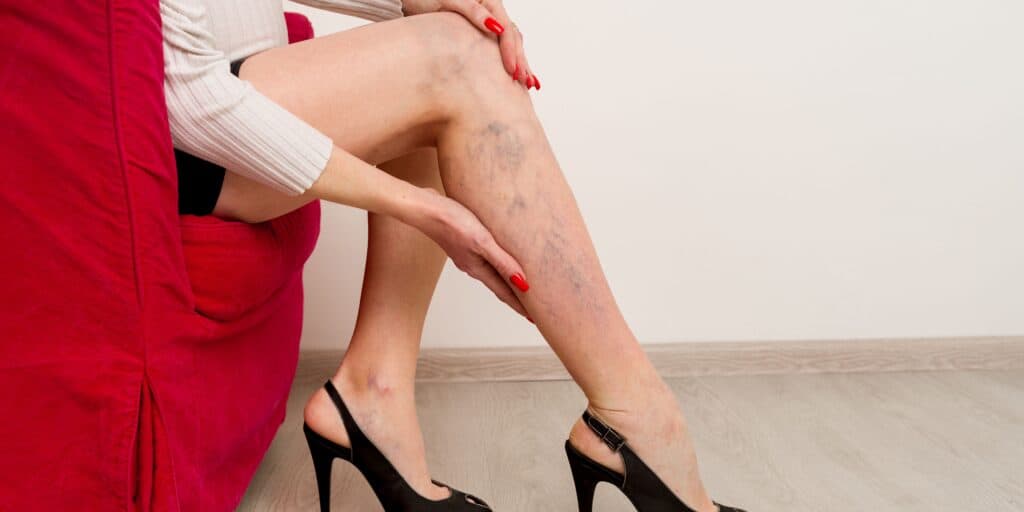Diagnosis and treatment options for spider veins
Spider veins appear as a web or a network of red lines very close to the surface of the skin. They are a less severe and milder version of varicose veins, so they very rarely cause pain or discomfort. However, the cause of spider veins is similar to that of varicose veins, where the valves in the veins weaken and allow backflow of blood. This results in stretching of the walls of the veins, making them more visible from the surface of the skin. Spider veins are often red, but they can also be blue or purplish.
DIAGNOSIS
You may undergo one or a combination of these tests in order to fully evaluate for spider veins and any complications.
● Physical examination: While you are standing, your doctor will look for any swelling in your leg. They will also look for reddish/bluish web of lines on your leg, indicating the presence of spider veins.
● Ultrasound scan: During an ultrasound scan, ultrasound waves are bounced against the structures in the body to create an image of those structures. Gel is first applied to your leg, before the scanner (transducer) is run over it. The doctor will look for presence of any blood clots in the deep veins which will indicate presence of deep venous thrombosis (DVT). Your doctor will also check for abnormalities in the direction of blood flow in your veins which may suggest underlying venous reflux.
● Venogram: A venogram involves the injection of contrast (type of dye) followed by an X-ray scan to allow the doctor to observe how blood is flowing in the venous system, and check for any underlying venous flow obstruction.
After these tests, your healthcare provider will advise you on whether you need spider veins removal, Singapore.

PREVENTION
● Avoid inactivity: Staying in one position (especially standing) for a long period of time makes it harder for your heart to pump the blood from your legs back up towards your heart. Gravity is working against your circulation and without the aid of the contracting calf muscles, your blood will not be able to flow well. Hence, you should always try to do some waking exercises every hour if you are travelling long distances.
● Maintain a healthy weight: This is important as obesity brings about many health issues and conditions. Excess fats place pressure on your blood vessels and increase the pressure of the blood in them, which can then damage the blood vessels. By maintaining a healthy weight, your blood vessels are able to function well.
● Exercise regularly: Not only does this promote your physical health, it also enables you to get your heart pumping and strengthen your vascular system and the walls of your blood vessels. In general, your circulation will improve with exercise. You can do cardio exercises like cycling, running, walking, and swimming.
● Wear compression garments: Compression garments are made of an elastic material that is tight and body-hugging when you put it on. They place slight pressure on your blood vessels and help to boost blood flow. They prevent the blood vessels from bulging out even if the valves are beginning to weaken.
● Eat more fibre in your diet, and consume less sodium: Fiber has been found to help with good blood circulation and lower blood cholesterol as well as pressure, all of which will lower your risk of having spider veins.
TREATMENT
- Cryo-Laser and Cryo-Sclerotherapy (CLaCs): This procedure involves both a chemical and a mechanical approach to seal off damaged veins. The laser is targeted at the specific veins where the valves are weak. At the same time, a chemical sclerosant (chemical that seals the veins) is injected, all while the area is kept at a temperature of -20℃. The diseased vein is sealed close and will be no longer visible.
- ClariveinTM/Mechanochemical Ablation: A catheter is inserted which physically stimulates the walls of the veins, while a chemical sclerosant is injected into it. The diseased vein is sealed close and will be no longer visible.
- VensealTM/VenaBlock Glue Closure: Venseal is a medical product that can be used to fill up veins with weak valves, diverting the blood flow into other blood vessels nearby. After this procedure is done, your spider veins should disappear.
- Radiofrequency Ablation: Radiofrequency waves are used to heat up the diseased veins, scarring the walls of these blood vessels and sealing them off. In the same way as the other treatment methods above, blood no longer flows through the damaged blood vessels and you should no longer see the spider veins.
Often a combination of these procedure is done to achieve better results. Certain procedures are more suited to a particular segment of vein and your surgeon will be able to advise what combination of therapy will be required to achieve optimum results.
If you do have spider veins and are looking for a place to undergo spider veins removal, Singapore Vascular and Interventional Centre is always an option! We are located at Novena Specialist Centre, at 8 Sinaran Dr, #06-08 Specialist Centre, Singapore 307470. Feel free to book an appointment and drop by for a consultation! Contact details can be found below:
6694 6270 (Call)
9898 3595 (WhatsApp)
en*****@***********tr.com (Email)
REFERENCES
[1] https://www.healthline.com/health/varicose-veins#treatment-and-prevention
- Tags:
- Best spider vein treatment Singapore
- Broken capillaries treatment Singapore
- Cosmetic vein treatment Singapore
- Facial vein treatment Singapore
- Leg vein removal Singapore
- Minimally invasive vein solutions
- Non-surgical vein removal Singapore
- Red vein treatment Singapore
- sclerotherapy Singapore
- Singapore vascular specialist
- Spider vein care Singapore
- Spider vein laser treatment Singapore
- Spider vein removal Singapore
- Spider vein therapy Singapore
- Spider vein treatment Singapore
- Spider Veins
- Spider Veins Removal Singapore
- Thread veins Singapore
- Vein Clinic Singapore
- Vein doctor Singapore
- Vein removal procedures Singapore
- Visible vein removal Singapore
